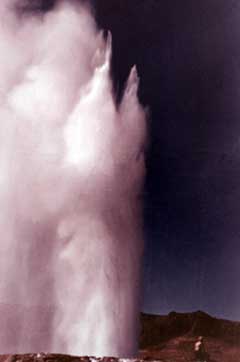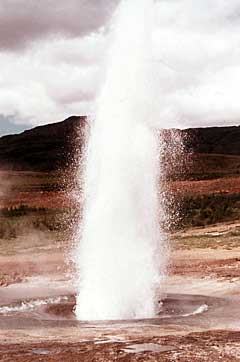|
Lobby >
Exhibits > Hot
Water Treasures > Global Context > Iceland
Iceland
ORIGIN OF "GEYSER"
Approximately 50 geysers and perpetual spouters are scattered throughout Iceland in at least a dozen places. Hveravellir, in the central part of Iceland, is one of the most active basins, although most of its geysers are small.
Geysir (also known as the Great Geysir) is located in Iceland’s Haukadalur Valley. Its name was derived from the Icelandic verb “gjósa,” (meaning “to erupt”) and is now shared by all of the geysers in the world. Accounts of a geyser at Haukadalur date back to 1294. In 1630 the eruptions of Geysir and other surrounding geysers were reportedly so violent that the floor of the valley trembled. Throughout its history, Geysir has repeatedly become dormant, only to be revived by earthquakes. Such a reawakening occurred following an earthquake in June 2000. Geysir now has minor eruptions several times per week, punctuated by rare major eruptions that reach 200 feet (61 m) high.
 |
 |
| The Great Geysir |
The Strokkur |
The second most famous geyser in Iceland is The Strokkur, (Icelandic for "churn"). It is located near Geysir and has frequent eruptions, up to 70 feet (20 m).
Next Area: New Zealand

|

This work is supported by

 |
|






